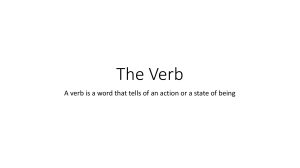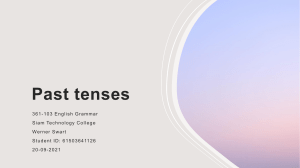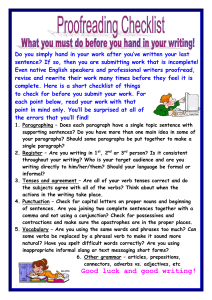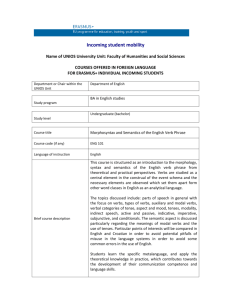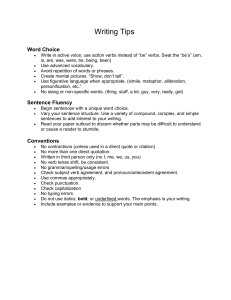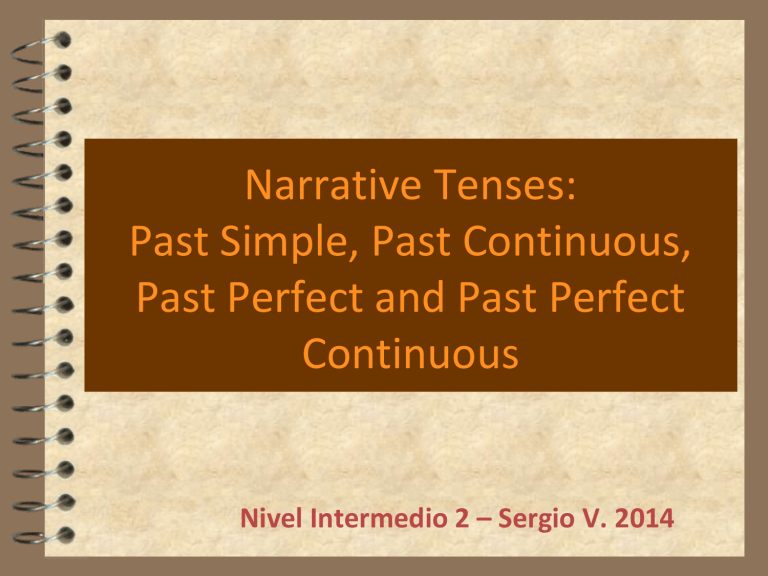
Narrative Tenses: Past Simple, Past Continuous, Past Perfect and Past Perfect Continuous Nivel Intermedio 2 – Sergio V. 2014 Narrative tenses like the Past Simple, Past Continuous, Past Perfect and Past Perfect continuous are used to tell stories or to talk about activities and situations that happened in the past. LET'S CHECK THE TENSES! PAST SIMPLE - The Past Simple expresses an action that started and finished in the past: I had breakfast and I went to work. - It also expresses a past habit. It usually goes after WHEN: She played in a band when she was young. * It uses regular and irregular past verbs and the auxiliary DID or DIDN'T. PAST CONTINUOUS - The Past Continuous is used to describe a longer continuous past action which was in progress when another action happened: We were having dinner when the plane hit some turbulence. - Its verb form is: was/were + verb -ing - We can't use state verbs with the Past Continuous: - Emotions: need, love, hate... - Possession: want, belong, have... - Sense: smell, see, hear, taste... - Thought: think, remember, believe, know... - The Past Continuous usually goes after WHILE or AS. PAST PERFECT - The Past Perfect describes a past action that happened before another action in the past. When we arrived at the airport, we suddenly realised that we had left one of the suitcases in the taxi. - Its verb form is HAD + Past Participle PAST PERFECT CONTINUOUS - We use the Past Perfect Continuous to talk about a longer continuous action that was going on before the main events happened. Non-action verbs are not normally used in the Past Perfect Continuous: We had been driving for about two hours when we finally got to the hotel. PAST PERFECT SIMPLE OR PAST PERFECT CONTINUOUS? The Past Perfect Continuous emphasises the continuation of an activity: She was crying because she had been reading a very sad book. The Past Perfect Simple emphasises the completion of an activity: She didn’t want to see the film because she had already read the book. What happens when we tell a story? The Past Continuous sets the scene. The Past Simple describes the main events. The Past Perfect makes the story more interesting. LET'S PRACTICE I. Complete the story using the past simple, past perfect, or past continuous of the verbs in brackets. It (be) Tuesday evening and I (get) ready to go to bed when the phone (ring). To my surprise, it (be) my friend Peter. He (call) from his mobile and he was very annoyed because he (lose) his keys and he (cannot) get into his flat. He (think) he (leave) them at work but now it was midnight and the office was closed so he (cannot) get in to check. Luckily I had the keys to his flat because a month before he (give) me a spare set so that I could look after his cat while he was on holiday. When he finally (arrive) to pick them up, it was three o'clock in the morning, and I (lie) on the sofa fast asleep. It was (be) Tuesday evening and I was getting (get) ready to go to bed when the phone rang (ring). To my surprise it was (be) my friend Peter. He was calling (call) from his mobile and he was very annoyed because he had lost (lose) his keys and he couldn't (cannot) get into his flat. He thought (think) he had left (leave) them at work but now it was midnight and the office was closed so he couldn't (cannot) get in to check. Luckily I had the keys to his flat because a month before he had given (give) me a spare set so that I could look after his cat while he was on holiday. When he finally arrived (arrive) to pick them up, it was three o'clock in the morning, and I was lying (lie) on the sofa fast asleep. Material prepared and selected by Danitza Lazcano Flores Teacher of English Master in Education and Educational Counselor Adapted by Sergio V.
